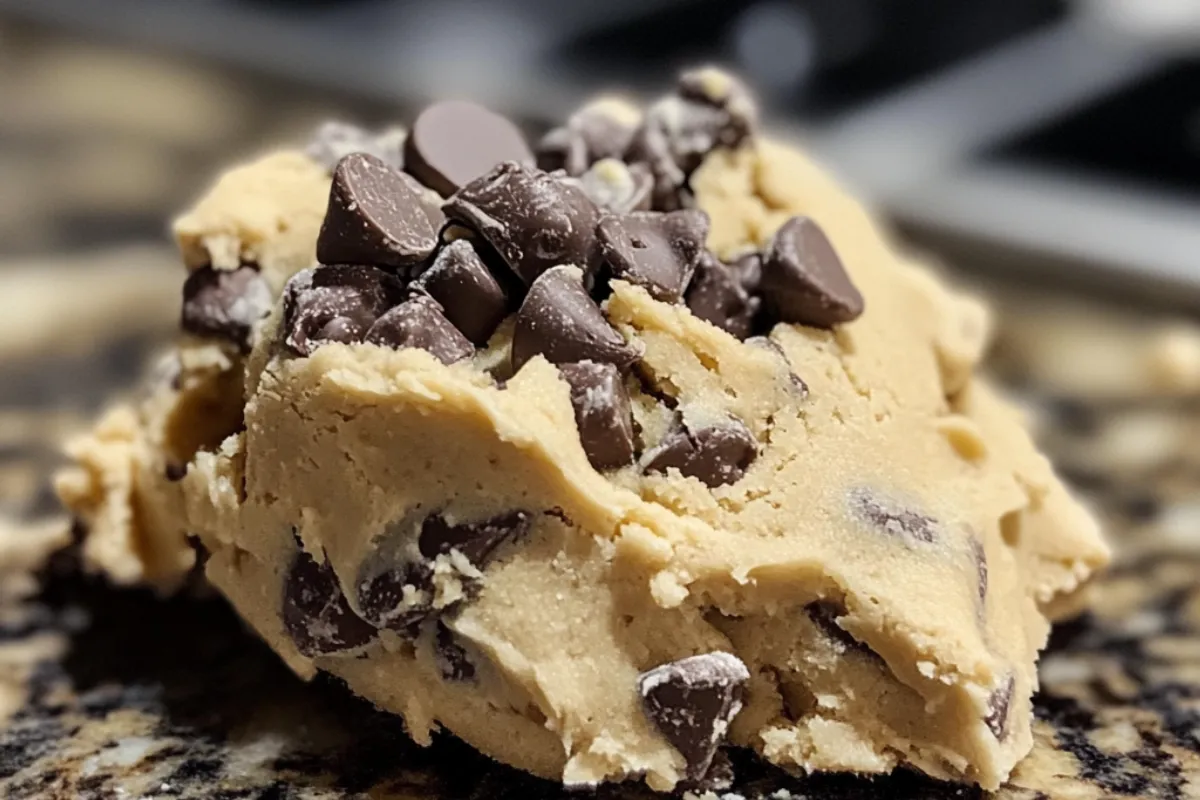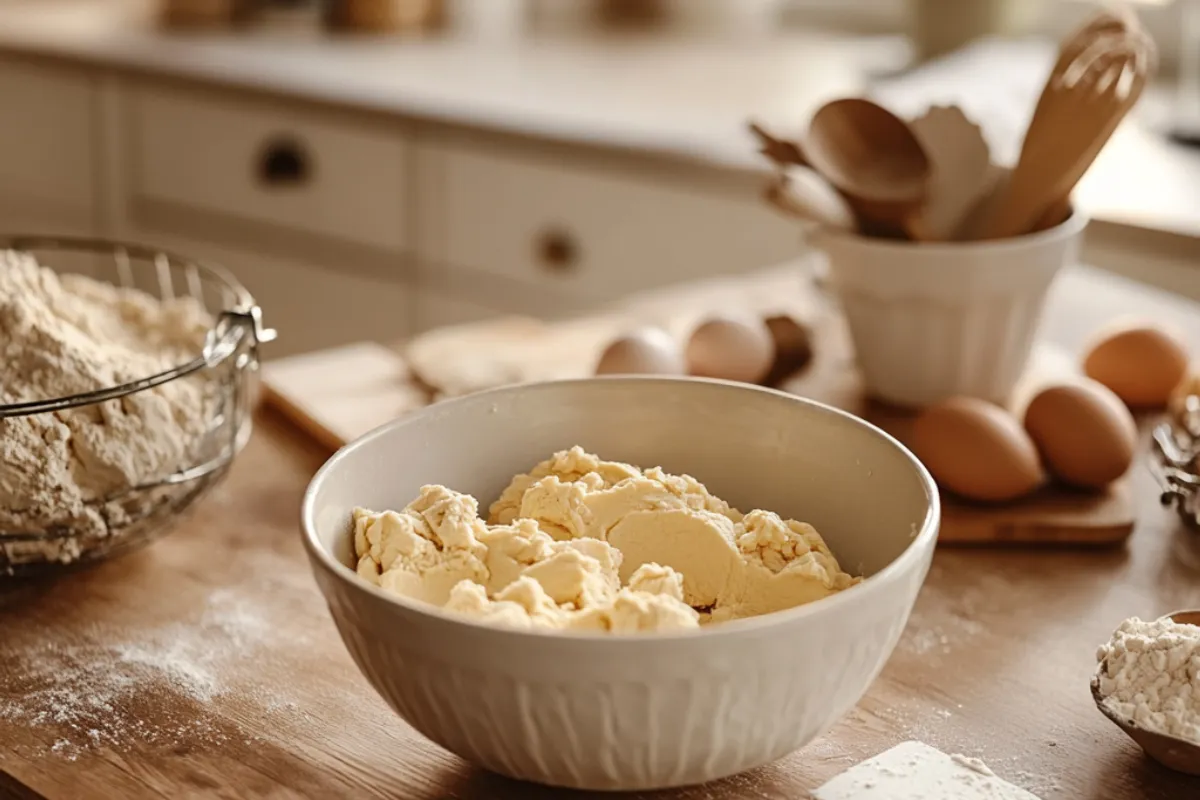Introduction to Cookie Dough Recipes
Cookie dough has been a beloved staple in homes worldwide, offering a versatile foundation for creating a range of delicious treats. Whether you’re crafting cookies, adding chunks of cookie dough to ice cream, or enjoying it straight from the bowl (responsibly!), the charm of this simple mixture cannot be overstated.
In this comprehensive guide, you’ll learn how to make cookie dough from scratch, ensuring it’s safe to eat raw or baked into your favorite cookies. We’ll explore creative ways to use cookie dough, discuss common mistakes, and even cover alternative cookie dough recipes for those with dietary restrictions. This is your one-stop source for mastering the art of cookie dough.
Essential Ingredients for the Best Cookie Dough
To achieve perfect cookie dough, you need the right ingredients. While the basics of cookie dough might seem simple, each component plays a vital role in the texture, flavor, and quality of the final product.
- Butter: Unsalted butter is typically preferred, allowing you to control the saltiness of your dough. Softened butter ensures even mixing and a smoother texture.
- Sugar: A mix of white and brown sugar is often used. White sugar gives cookie dough sweetness and helps with spreading during baking, while brown sugar adds moisture and a deeper flavor.
- Eggs: Eggs provide structure and richness. Room temperature eggs mix more easily into the dough, creating a smooth, even consistency.
- Flour: All-purpose flour is the go-to choice for cookie dough. It provides the necessary structure, but for those with dietary restrictions, gluten-free or almond flour are great alternatives.
- Leavening Agents: Baking powder or baking soda helps the cookies rise and ensures they have a light, airy texture.
- Vanilla Extract: Adds depth and warmth to the dough.
- Salt: Enhances the flavors and balances the sweetness.
Making the perfect cookie dough is all about balance and technique. Measuring ingredients accurately and following the steps carefully will yield consistent results every time.
Step-by-Step Guide to Making Basic Cookie Dough
Making basic cookie dough from scratch is simple, but the process requires precision to ensure a perfect outcome. Here’s how to make it:
Ingredients:
- 2 ½ cups of softened unsalted butter
- 2 cups of sugar (a mix of brown and white)
- 2 large eggs (room temperature)
- 1 tablespoon of vanilla extract
- 7 ½ to 8 cups of all-purpose flour
- 1 teaspoon of salt
- 1 teaspoon of baking soda
Instructions:
- Cream the butter and sugar: In a large bowl, cream the butter and sugar until light and fluffy. This step should take around 5-7 minutes and is essential for creating the right texture.
- Add the eggs and vanilla: Beat in the eggs one at a time, ensuring each is fully incorporated before adding the next. Mix in the vanilla extract for a rich flavor.
- Combine the dry ingredients: In a separate bowl, whisk together the flour, salt, and baking soda.
- Incorporate the dry ingredients into the wet mixture: Gradually add the dry ingredients to the butter mixture, stirring continuously to avoid lumps. Stop once the dough starts to form.
- Chill the dough: Divide the dough into portions, wrap in plastic wrap, and refrigerate for at least 1-2 hours. This step prevents the cookies from spreading too much during baking.
You can now bake or store the dough for later use. For more baking tips, check out these cookie dough baking tips.
Popular Variations of Cookie Dough
Not all cookie dough is created equal! With so many variations, it’s easy to tailor a recipe to suit your preferences. Here are some of the most popular and unique cookie dough options:
- Classic Sugar Cookie Dough: Perfect for rolling out and cutting into shapes for holidays or special occasions. Add a bit of lemon zest for a fresh twist!
- Chocolate Chip Cookie Dough: The gold standard of cookie dough, loved by all. You can experiment by adding different types of chocolate—dark, milk, or white.
- Peanut Butter Cookie Dough: Rich and decadent, peanut butter adds a savory depth to the dough.
- Oatmeal Cookie Dough: For a heartier, chewier option, oatmeal cookie dough is packed with texture and flavor. Add raisins or chocolate chips for variety.
- Vegan and Gluten-Free Cookie Dough: Swap traditional butter and eggs for vegan alternatives like coconut oil or flax eggs. Almond flour and gluten-free flour mixes work beautifully for those avoiding gluten.
Experiment with different flavors and textures to make your cookie dough your own.
Creative Cookie Dough Uses
While baking cookies is the obvious choice, cookie dough has so many other exciting applications. Here are a few creative ways to enjoy cookie dough:
- Edible Cookie Dough: Safe to eat raw since it excludes raw eggs and uses heat-treated flour. This is perfect for cookie dough lovers who prefer not to bake.
- Cookie Dough Ice Cream: Add chunks of cookie dough to your favorite ice cream for a delicious treat. Consider freezing the dough before mixing it in for better texture.
- Cookie Dough Truffles: Roll the cookie dough into small balls, dip them in chocolate, and refrigerate until firm. These bite-sized treats are perfect for parties.
- Cookie Bars: Press the dough into a pan and bake as a sheet to make delicious cookie bars. These can be cut into squares and topped with frosting for an added indulgence.
- Freezing Cookie Dough for Later: Make extra dough, roll it into logs, and freeze. This way, you always have fresh cookie dough on hand for a quick batch of cookies.
By using cookie dough in these creative ways, you can enjoy its rich, buttery goodness in more than just cookies.
Common Mistakes When Making Cookie Dough
Even seasoned bakers can make mistakes when preparing cookie dough. Here are the most common pitfalls and how to avoid them:
- Overmixing the Dough: Mixing the dough too much activates the gluten in the flour, which can result in tough, dense cookies. Mix only until the ingredients are combined.
- Not Chilling the Dough: Skipping the chilling step can cause the cookies to spread too much while baking, leading to thin, crispy cookies instead of chewy, soft ones.
- Incorrect Measurement of Ingredients: Measuring too much flour or not enough butter can drastically alter the texture of your dough. Use a kitchen scale for the most accurate results.
- Using Cold Ingredients: Cold butter and eggs do not blend well, leading to unevenly mixed dough. Always ensure your ingredients are at room temperature before starting.
For more information on preventing these common baking mistakes, refer to this detailed guide on cookie dough baking tips.
Healthier Alternatives to Traditional Cookie Dough
If you’re looking for a healthier version of cookie dough, there are plenty of options to try. Whether you want to reduce sugar, cut down on fat, or make the dough more nutritious, you can still enjoy this treat in a more wholesome way.
- Low-Sugar Cookie Dough: Swap regular sugar for a lower-calorie alternative like monk fruit sweetener, stevia, or coconut sugar. These options reduce the glycemic impact while still providing sweetness.
- Whole Grain and Almond Flour Options: Instead of using all-purpose flour, try using almond flour or oat flour. These flours are rich in nutrients and add texture to your dough.
- High-Protein Cookie Dough: Add protein powder to the dough to create a high-protein snack. This is perfect for those looking to add a nutritional boost to their treats.
- Low-Fat Substitutions: Replace butter with coconut oil, applesauce, or Greek yogurt for a lower-fat version of your favorite cookie dough recipe.
These healthier alternatives provide all the flavor and texture of traditional cookie dough with fewer calories and more nutrients.
Cookie Dough for Dietary Restrictions
If you or someone in your household has dietary restrictions, you can still enjoy delicious cookie dough by making a few simple substitutions.
- Gluten-Free Cookie Dough: Swap all-purpose flour for gluten-free flour. Almond flour and oat flour are excellent options for a gluten-free version. Ensure that your baking powder and other ingredients are also gluten-free.
- Vegan Cookie Dough: Use plant-based substitutes like coconut oil or vegan butter in place of dairy butter. Flax or chia seeds mixed with water work well as egg replacements.
- Sugar-Free Cookie Dough: For diabetics or those avoiding sugar, use alternatives like erythritol or stevia. These sweeteners offer the same sweetness without the blood sugar spike.
These recipes allow everyone to enjoy cookie dough without compromising on flavor.
Frequently Asked Questions (FAQs)
- Is it safe to eat raw cookie dough?
Yes, as long as you use heat-treated flour and avoid raw eggs. For more information, check out these tips on safe raw cookie dough. - How can I make cookie dough without eggs?
You can substitute eggs with flax seeds, chia seeds, or applesauce. This works especially well in vegan recipes. - How long can cookie dough be refrigerated?
Cookie dough can be stored in the refrigerator for up to 3-4 days. Make sure it’s wrapped tightly to avoid drying out. - What’s the best way to freeze cookie dough?
Freeze the dough in individual portions or logs wrapped in plastic wrap. It can be stored for up to 3 months. - Can I make cookie dough in advance for later use?
Yes! Make extra and store it in the freezer. Just thaw it in the refrigerator before using.
Conclusion
Cookie dough is a versatile and beloved ingredient, whether you’re baking cookies, making edible cookie dough, or using it in other desserts. With the right techniques, ingredients, and knowledge of common pitfalls, you can make perfect cookie dough every time. Experiment with different flavors, enjoy creative uses, and explore healthier alternatives for those with dietary restrictions.
So, get your ingredients ready and start making your own cookie dough—you won’t regret it!


